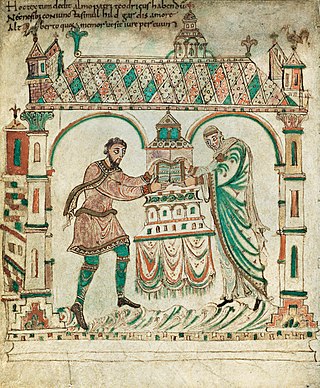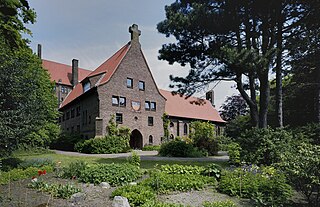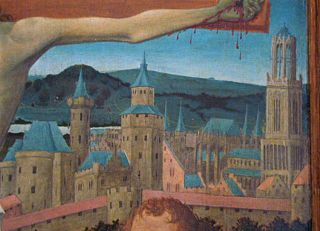
The Hook and Cod wars comprise a series of wars and battles in the County of Holland between 1350 and 1490. Most of these wars were ostensibly fought over who should hold the title of "Count of Holland", but some have argued that the underlying reason was a power struggle conducted by the bourgeois in the cities against the ruling nobility.

The Lords of Brederode were a noble family from Holland who played an important role during the Middle Ages and the Early modern period. The family had a high noble rank and hold the titles Count of Brederode, Count of Gennep, and furthermore they ruled the souverain Lordship of Vianen, the Viscountship of Utrecht among other feudal titles.

The Egmond Gospels is a 9th-century Gospel Book written in Latin and accompanied by illustrations. It is named after Egmond Abbey in what is now the Netherlands, to which it was given by Dirk II and his wife Hildegard, and where it remained for six centuries. It is most famous for being the earliest surviving manuscript showing scenes with Dutch people and buildings, and represents one of the oldest surviving Christian art treasures from the Netherlands. The manuscript has been owned by the Royal Library of the Netherlands since 1830.

Egmond Abbey or St. Adalbert's Abbey is a Benedictine monastery of the Congregation of the Annunciation, situated in Egmond-Binnen, in the municipality of Bergen, in the Dutch province of North Holland. Founded in 920-925, and destroyed during the Reformation, it was re-founded in 1935 as the present Sint-Adelbertabdij, in the Diocese of Haarlem.

Egmond Castle, also called the Ruins of Egmond, is a ruined medieval castle in the Dutch province of North Holland. It is located in Egmond aan den Hoef in the municipality of Bergen and lies about 7 kilometres (4.3 mi) west of Alkmaar. The castle dates from the 11th century and is the ancestral seat of the Egmond family, whose members became sovereign Dukes of Guelders, Counts of Egmond and Princes of Gavere, Counts of Buren and Leerdam. It is a national monument of the Netherlands.
Jan van Brederode was lord of Brederode and during his life lay brother and soldier.
Dirk van Teylingen, lord of Brederode was lord of Brederode and landdrost of the counts of Holland.
Willem van Brederode was Lord of Brederode.

Dirk III van Brederode was lord of Brederode.
Reinoud I van Brederode was the 6th lord of Brederode.

Walraven I van Brederode was Burgrave of Stavoren from 1400 to 1401, lord of Brederode from 1402 to 1417, and Stadtholder of Holland from 1416 to 1417.

Brederode Castle, also called the Ruins of Brederode, is located near Santpoort-Zuid. The castle was founded in the second half of the 13th century by William I van Brederode (1215–1285). William was a descendant of the lords van Teylingen, who were related to the counts of Holland. The castle formed part of the high lordship Brederode, which had been given in loan in the 13th century to the lords of Brederode by the count of Holland.

Reinoud II van Brederode was Lord of Vianen, Ameide, Lexmond, Hei- en Boeicop, Meerkerk, Tienhoven and Twaalfhoven.

Arnold I of Egmond, in Dutch Arnoud, Arend, or Arent van Egmond, was Lord of Egmond and IJsselstein.

The Utrecht war of 1481–83 was a diocesan feud in the Prince-Bishopric of Utrecht between 1481 and 1483, influenced by the ongoing Hook and Cod wars in the neighbouring County of Holland. It was also a battle for control over Utrecht between the Dukes of Burgundy in the person of ruling Bishop David of Burgundy, and the Duchy of Cleves, which sought to replace him with Engelbert of Cleves.

John I, Lord of Egmond was Lord of Egmond, Lord of IJsselstein, bailiff of Kennemerland (1353–1354) and stadtholder of Holland.
William II, Lord of Egmond or Willem II, heer van Egmond was a ruling Lord of Egmond.
Jan Bouwensz, also known as Jan Boudynsz and Jan Baldewini was a Dutch Landsadvocaat.

The Cod Alliance Treaty was a 1350 or 1351 treaty by which a number of nobles and cities allied with William V of Holland against his mother Margaret II, Countess of Hainaut and her allies. It was signed in the first phase of the Hook and Cod wars.

The Battle of Veere was a small naval battle that took place in late May 1351 during the Hook and Cod wars.
This page is based on this
Wikipedia article Text is available under the
CC BY-SA 4.0 license; additional terms may apply.
Images, videos and audio are available under their respective licenses.










